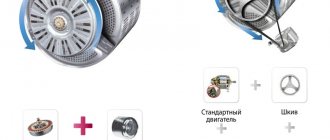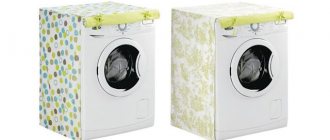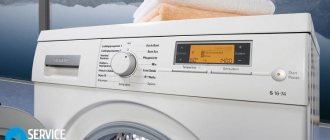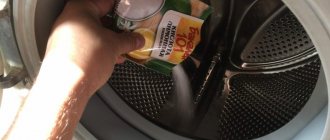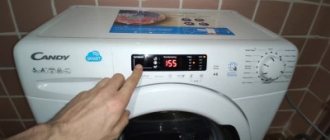Before scientific and technological progress began to steadily gain momentum, washing methods and detergents were primitive. The first washing machine radically revolutionized human life and confidently entered people's homes. If you are interested in the history of its creation, you have come to the right place - we will tell you the most interesting moments of the appearance of washing machines.
Washing in ancient times
It is not known for certain when exactly people learned to wash dirt from clothes with water. But this happened, of course, quite a long time ago. Primitive people, of course, hardly did laundry. However, historians were able to find out that a mixture of fats and alkalis, intended to remove dirt from clothes, was made more than 5 thousand years ago in ancient Sumer and Babylon.
The legend of soap
There is even one interesting ancient legend regarding the invention of soap by people. According to legend, the Latin word sapo (soap) comes from the name of Mount Sapo in Ancient Rome. In this place, according to legend, sacrifices to the gods were once upon a time made. The fat released during the burning of animals was subsequently washed away by rain into the Tiber flowing under the Tiber mountain. Soon, ancient housewives noticed that clothes were washed best in the river right next to the place of sacrifice.
Where was the washing machine invented: the first mechanical devices
With the invention of soap, removing dirt from laundry, of course, became much easier. However, the washing procedure was still quite difficult. And of course, man has more than once tried to facilitate this process using various kinds of mechanical devices.
We’ll talk about who first invented the washing machine a little later. The inventors of the primitive technology of lightweight washing in ancient times were ordinary sailors. They simply soaked their dirty clothes in water, soaped them thoroughly, tied them to a rope and threw them from the ship into the sea.
In the middle of the 19th century. One of the American gold miners came up with the idea of using animal power to wash clothes. In 1851, this entrepreneur designed a primitive device driven by 12 mules. When answering the question of who invented the washing machine, you should first of all remember this person. However, his specific first and last name, unfortunately, have not been preserved in history. In any case, the machine invented by the gold miner worked quite effectively. She could wash up to 15 shirts at a time.
Thus, the answer to the question of which country invented the washing machine is the USA. Later, enterprising Americans, who thought of using pack animals for washing, even opened the world's first paid laundry.
The most convenient mechanical washing device was invented in the 19th century. American Jace King. The machine he made looked like a tub with a perforated cylinder on a rotating axis. This mechanism had to be set in motion manually. But this device, of course, still made the washing process much easier.
Although King's invention was extremely imperfect, it gave rise to many other washing machine ideas. By 1827, for example, about 2000 similar mechanisms had been patented.
Who invented the rotating
The rotating drum appeared in 1851, in the invention of J. King. In 1861, rollers were invented for wringing out washed clothes, although in fact they were known in Ancient Rus', where the laundry was passed between two logs, as a result of which excess water was removed from it. So they were rather not invented, but rather turned from manual ones to mechanical ones. Such rollers remained in washing machines for almost 150 years, and even many semi-automatic machines were equipped with them only recently.
Each era of washing machines begins with their mass production. So it is with rotating devices - in 1900, Miele & Cie from Germany, which manufactures separators for dairy products, launched the production of butter churns with rotating blades.
One of the company’s engineers named Karl Miele, having finalized the design, adapted it for washing. The brilliant idea was immediately brought to life, and in the same year serial production of rotating washing machines began. Thus, the year of birth in Europe for washing machines is deservedly considered to be 1900, and Karl Miele is considered to be the one who invented the rotating SMA.
When did serial production begin?
The first person to launch a mechanical washing device was William Blackstone. This inventor invented and assembled his own machine especially for his wife’s birthday in 1874. Later, convenient mechanical equipment began to bring the family a good income.
In Europe, mechanical washing machines first began to be produced in 1900. The inventor of new equipment designed to remove dirt from clothes in this part of the world was the German Karl Miele. The machine he assembled worked on the basis of a butter churn. A small batch of such mechanisms was brought to Russia at that time.
Creating an automatic washing machine
In 1948, the first software device was developed for washing machines. For autonomous operation of the device, the necessary washing functions were printed on perforated cards. This is how an automatic washing machine was created in America. A year later, a centrifugation mode is installed in the design, and now the machine begins to spin out the laundry.
Models are being developed with different options for loading things into the drum: vertical and frontal. Clothes are washed, wrung out, and dried. After 2 years, the production of this equipment is put into industrial production in Europe.
In 1978, the first washing machine appeared, which had a special control program in its design. The washing machine was operated using a microboard. In the early 80s, automatic cars were manufactured almost all over the world.
In the 90s, washing devices with different technologies were developed. Washing machines now operate on the principle of “smart” technology. Every year, manufacturers improve their products, this allows them to solve many different problems.
Today, various technologies are available to consumers; in short, among the most popular are:
- Aqua Stop.
- Power Stick.
- Add Wash.
- Eco Bubble.
The world's first electric model
Mechanical washing devices produced since the mid-19th century. before the beginning of the 20th century, of course, they could make life much easier for housewives. Laundries were very popular among the population in those days. But who came up with the modern version of the washing machine, that is, with an electric motor?
This model was first developed in 1908. Its inventor was the American Alva Fisher. After electric machines went on sale, there was no need to spend physical effort on washing. However, the ultra-modern Fischer machines at that time also had one rather serious drawback. Unfortunately, they were no different in terms of safety. All parts of these units were open.
The Fisher unit was called Thor. The machine was equipped with a drum made of wood and rotated alternately in one direction or the other. At the bottom of this equipment there was a special lever, through which the device that rotated the drum was coupled to the shaft of the electric motor. In 1910, Thor machines were put into mass production by the Hurley Machine Company.
Activator machines
Since farmers in America and peasants in Western Europe began to use steam engines much earlier than factories in cities, they were the first to come up with the idea of simplifying the work of their wives.
So, they massively designed strong barrels, with a rotating crosspiece (activator) located inside. It received energy for movement through a drive belt or toothed transmission shafts.
Expert opinion
I work in the household appliance repair industry. Extensive experience in restoring washing machines and dishwashers.
Ask a Question
Such devices were quite stylish, and were constantly being improved. For this reason, today such washing machines occupy a place of honor in antique museums. They also became the prototype of semi-automatic machines, which became possible thanks to another American, Fisher.
Based on existing developments, this entrepreneur tried in 1908 to equip a washing machine with an electric motor. According to his idea, the model could be suitable for household use, but his new product was not successful.
This was due to the high danger of operation, since the moving elements were located outside. However, the idea became a breakthrough because it allowed us to avoid hard work.
Activator washing machine
Further, development began more rapidly and in those years several companies appeared that are still known today:
- Upton in 1911 began to build a small factory producing semi-automatic machines. Over time, his brainchild turned into the world-class company Whirlpool.
- Italian Antonio Zanussi also decided to start producing electric washing machines in 1916. Having started producing semi-automatic machines, he was able to make his company the largest in Italy. Zanussi later reached world level.
- The Koreans also did not stand still - there Lee Byung Chol completed the construction of a rice mill in 1930, giving rise to the future Samsung. The company later also began producing washing machines.
As of 1940-1950, there were already almost 2 thousand companies in Europe, Asia and America that were engaged in the production of washing machines. Although semi-automatic machines have reduced the effort required for washing by tens of times and made this process easier, full automatic machines have not appeared soon.
Do you store laundry in the washing machine?
Oh yes! No.
The evolution of washing machines in the 20th century.
In the 19th and early 20th centuries. The companies produced mainly industrial machines used in paid laundries. Compact units suitable for installation in private homes appeared on sale only in the 20s of the 20th century.
By this time, more than 1000 companies were already producing washing machines. Various changes were constantly made to the design of this equipment aimed at improving its ease of use and safety.
It was in the 20s of the last century that wooden tanks of washing machines were replaced with enameled metal ones. At the same time, two types of similar equipment that still exist today were identified. Vertical machines and more convenient and expensive drum machines were supplied to the market.
In 1924, among other things, devices appeared on sale that were designed not only for washing, but also for spinning clothes. The American company Savage Arms Company was the first to supply such units to the market.
Design
The aerodynamic design is a twin-engine low-wing aircraft with a swept wing, single-fin vertical tail, and turbofan engines located under the wing.
A characteristic external feature of the A320 is the slightly sloping front landing gear.
The aircraft design makes extensive use of composite materials (about 20%). Glass-fiber reinforced plastic, Carbon-fiber reinforced plastic, honeycomb core are mainly used. Almost all wing mechanization is made of composite materials (slats, flaps, spoiler panels , hatches, nose cone), and the vertical tail is entirely made of composite. The leading edge of the horizontal stabilizer is also composite.
A special feature of the Airbus A320 is its advanced technical equipment (by the standards of the 1980s) cockpit and fly-by-wire control system (EDCS). Instead of mechanical dial instruments, information about the position of the aircraft and the state of its engines and auxiliary systems is displayed on six cathode-ray screens (after the start of production of the A318 - on LCD), occupying most of the instrument panel. In addition, classic aircraft steering wheels are replaced by side sticks (RUS), also called sidesticks, located on the sides of the cockpit: the RUS for the pilot sitting on the left (aircraft commander) is located to the left of his seat, and the RUS for the pilot sitting on the right ( co-pilot), located to the right of his seat. The control sticks are connected to the steering planes in the following way: any movement of the sidestick is processed by on-board computers and the information is transmitted via wires to the hydraulic actuators, which make the necessary movements of the steering planes (fly by wire technology). The high level of automation in controlling the aircraft and its systems made it possible to limit the number of crew members to two pilots.
The aircraft is equipped with a digital avionics complex EFIS manufactured by the French company, consisting of six color multifunctional displays for displaying flight and navigation information, as well as data on the operation of on-board systems and failure warnings. All avionics comply with the ARINC 700 standard.
Compared to other airliners of similar size, the A320 series features a spacious passenger cabin with large overhead bins for carry-on luggage, large lower deck (cargo) deck cargo capacity and wide luggage hatches. After the release of the A318, the remaining aircraft of the A320 family, mainly produced after 2000, also applied innovations (Enhanced version) introduced during the production of the A318, such as: replacement of cabin cladding panels; more spacious shelves for hand luggage (internal volume increased by 11%); new Flight Attendant Panel (FAP) with touch display; individual lighting above each passenger (Reading lights) based on LEDs; the ability to adjust the brightness of the main lighting in the cabin from 0 to 100%; LCD displays in the cockpit instead of cathode ray displays. Some computers, computer logic, changes to mechanisms, and much more were also replaced. For these and other reasons (including relatively low maintenance costs), the A320 is very popular around the world.
On April 26, 2012, the first A320 family aircraft with modified winglets was released.
Who invented the automatic washing machine
In subsequent years, models with mechanical timers and drain pumps, among other things, appeared on the market. Such machines, of course, were already very convenient to use. However, housewives still had to constantly be near the washing machine - turn the water supply tap on and off, start and stop the engine, etc.
The first truly fully automated unit appeared on the market only in 1951. Unfortunately, it is not known who invented the automatic washing machine specifically. The name of the inventor has not been preserved in history. In any case, the new machine was very convenient to use. The automatic unit had a spin function and two control toggle switches.
The first semi-automatic machines
Another important step in the development of washing machines was the invention of the American inventor Alva Fisher, who created the first electric washing machine. It was the first semi-automatic washing machine with a motor that could operate independently. Needless to say, the appearance of such washing machines created a real sensation on the market and all progressive housewives sought to acquire this miracle of technology. Already in the 20s of the 20th century, there were more than 1,400 companies producing washing machines around the world on the market.
New generation equipment
So, who invented the automatic washing machine is unknown. In any case, such devices were convenient to use but, of course, still required improvement.
In the 70s of the last century, washing machines began to be equipped, among other things, with microprocessors. After this, the units added a drying function, which was not very popular due to its uneconomical nature. Also, new devices could wash clothes in different modes.
In the mid-90s, the Fuzzy Logic system was developed, which became a real revolution in the production of washing machines. Equipment has begun to be supplied to the market that can independently control the water temperature, the volume of loaded items, the concentration of detergents, etc.
Modern SMA
In modern models, discrete logic has been replaced by Fuzzy Logic (read more about it in the corresponding article). Its distinctive feature is the mass of parameters that the user can set, as well as information that is read by sensors and reported to the control unit.
In the latest developments, Fuzzy Logic has been replaced by UseLogic - the system analyzes all parameters of the laundry, determining the optimal washing process. During the mode itself, processes are analyzed, examined and adjusted - this reduces the consumption of resources and detergents. At the same time, the quality of washing and the impeccable appearance of the laundry are maintained.
Clear Water sensor is a development that analyzes water contamination. If the sensor tells the board that the water is too cloudy, the system will automatically initiate an additional rinse.
We can discuss the cars of our time endlessly, but this is a topic for a separate article. And you have already learned the most interesting things about the history of the emergence and development of this industry.
Washing machines in the USSR: interesting facts
So, we found out who invented the washing machine. The world's first mechanical device was assembled by an unknown American gold miner. The electric model of such household appliances was invented by Fischer.
European and American housewives began using washing machines at the beginning of the 20th century. In the USSR, such equipment appeared only in 1925. Unfortunately, in those days only the wives of party nomenklatura could use it. In the 20-30s, cars were imported to the Soviet Union mainly from America.
Ordinary Soviet housewives were forced to wash on ordinary corrugated boards almost until the “thaw”. Directly in the USSR, washing machines began to be produced only in the middle of the century.
The first household washing units were supplied to Soviet stores from the Baltic states. The Riga RES plant was engaged in their production. The first machines that appeared in the 50s were called “EAYA-2” and “EAYA-3”. The price for these units was about 600 rubles. at a cost of 1500 rubles. After some time, a new generation of washing machines, “Riga 54,” appeared in stores, which could load up to 2.5 kg of laundry.
The first unit with a timer in the USSR was released in 1966. The new machine “Vyatka” was a huge vertical tank with a screw in the bottom. The first units with a timer were a real shortage and were sold exclusively in Moscow.
Where it all began
Background to the emergence of washing technology
Before the active development of scientific and technological progress, washing methods were quite primitive. The name of the first inventor of the machine is still unknown, since applications for its registration were received regularly and in large quantities. The devices were not much like modern ones, but they could confidently be called prerequisites.
At the end of the 18th century, the washboard appeared, which served people for many years. It was widespread in Soviet times.
During these same years, the American Nathaniel Briggs invented the washing device. It was in the form of a wooden tub with a rotating frame. The high labor costs did not justify the purpose of the apparatus.
Until now, no exact answer has been given about the time of origin and the creator of the washing machine.
The appearance of the first washing machines
The patented device appeared in the mid-19th century. The world's first washing machine was created by American inventor James King. Outwardly, it was very reminiscent of a modern device, despite the fact that it was manually operated.
From that time on, improvements in the washing process began to occur at an accelerated pace. Until 71 of the 19th century, there were about 2 thousand patents for devices in America. Many washing machines were not suitable for performing their basic functions. Their operation did not last long, since the reliability of the device left much to be desired.
One of the first laundries was opened by an inventor from California in 51 of the 19th century. He designed a machine that could wash 10-15 items at a time. No human labor was used to operate the device. It was harnessed to 10 mules. The Californian charged a certain amount for washing clothes and thereby earned his living.
Launch of washing equipment into mass production
The first person to invent a washing machine and put it into mass production was William Blackstone. It was manually operated and sold for two and a half dollars per unit. The inventor gave the first constructed model to his wife on her birthday. The industrial enterprise founded by Blackstone continues to operate to this day.
Since the laundry needed to be spun after washing, and this procedure also required considerable effort, a device was invented that made it easy to get rid of excess water. It consisted of two rollers rotating towards each other. Wet laundry passed through them and was wrung out, while you had to turn the handle. Not long ago people stopped using this invention.
Washing appliances with motor
In Europe, washing machines began to appear at the beginning of the 20th century. The design began to use a motor, which initially worked using combustible fuel. But the gasoline-powered mechanism did not take root, since the smoke and smell emanating from it adversely affected the cleanliness and freshness of things.
Subsequently, the Germans improved production technology, which led to the emergence of the first electric washing machine. The creator of this device, called "Thor", is Alva Fischer. The structure was made of wood and looked like a drum. Washing was carried out with rotating movements eight times in each direction.
Soviet automatic cars
The answer to the question of where the washing machine was invented is, of course, America. It was in the USA that the most convenient and functional units of this type were initially produced. However, household appliances of this variety produced in the Soviet Union in the last century were quite reliable and ergonomic.
In the 70s of the last century in the USSR, under an Italian license, an enterprise was built that began producing Vyatka-automatic machines. These units were twin sisters of the Ariston models and were extremely popular among Soviet housewives.
The first “Vyatka-automatic machines” went on sale in 1980. These units were quite expensive - about 400 rubles. (two salaries of a Soviet engineer). But they still bought them up very willingly.
Rating for housewives
As for the USSR, development also took place there, although not on such a scale. So, until the beginning of 1925, the population was not at all familiar with such equipment, but they began to purchase it from foreign companies for nomenklatura workers.
There was still a choice of washing machines in the USSR, but mostly these were the prototypes of “Miele” and “Husqvarna”, which are known as “Vyatka” and “Riga”.
When the Second World War ended, industry began to recover in the country and the leadership did not ignore developments in this area. Thus, several enterprises appeared that produced semi-automatic devices.
16 years have passed and the Kirov plant also began producing analogues called “Vyatka”. They had almost no differences from the proposals of the Riga enterprise - with the same round tanks into which water was poured with a bucket. The first Vyatka produced had one advantage - a mechanism of two squeezing rollers was attached to it.
But already in the 70s the situation improved significantly, as even more enterprises joined the production. As a rule, in any city with a population of more than a million people there was a factory for the production of typewriters. This allowed people to see the Chaika, Volna, Volga, Kyiv and many others models in stores.
However, they differed from each other only in name, since they were strikingly similar. The only advantage turned out to be an impressive service life - even today some farms use them, despite their age of 40 or 50 years.
I work in the household appliance repair industry. Extensive experience in restoring washing machines and dishwashers.
Further, after the collapse of the USSR, foreign corporations began to build factories in post-Soviet countries to produce products for the domestic market. Their quality and cost turned out to be appropriate. Therefore, consumers still prefer models assembled in Europe or Asia.

